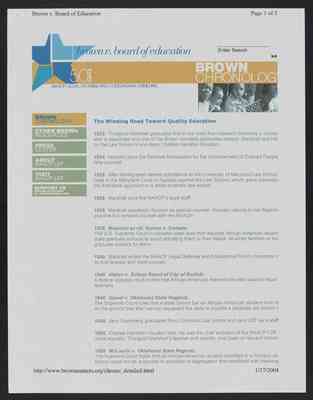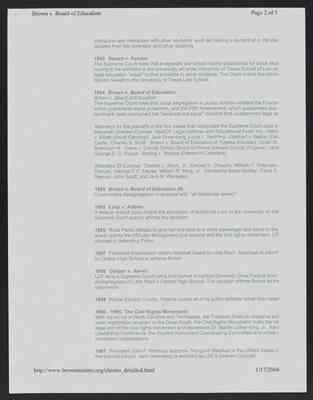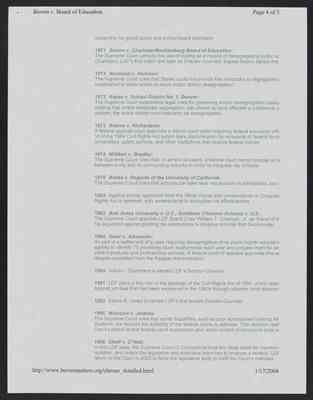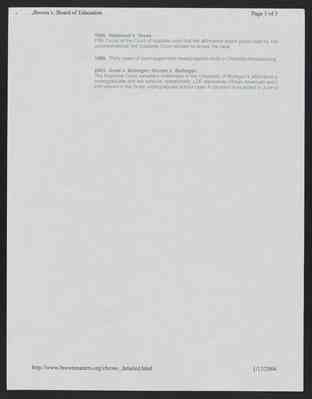Pages
26
Brown v. Board of education Page 1 of 5
The Winding Road Toward Quality Education
1933 Thurgood Marshall graduates first in his class from Howard University's School also a classmate and one of the Brown counsels, graduates second. Marshall and Hill by the Law School's vice-dean Charles Hamilton Houston.
1934 Houston joins the National Association for the Advancement of Colored People time counsel.
1935 After having been denied admittance to the University of Maryland Law School, case in the Maryland Court of Appeals against the Law School, which gains admission the first black applicant to a white southern law school.
1936 Marshall joins the NAACP's legal staff.
1938 Missouri ex rel. Gaines v. Danada: The U.S. Supreme Court invalidates state laws that required African-American studen state graduates schools to avoid admitting them to their states all-white facilities or bui graduate schools for them.
1940 Marshall writes the NAACP Legal Defense and Educational Fund's corporate c its first director and chief counsel.
1940 Alson v. School Board of City of Norfolk: A federal appeals court orders that African-American teachers be paid salaries equalteachers.
1948 Sipuel v. Oklahoma State Regents: The supreme Court rules that a state cannot bar an African-American stuent from its on the ground that she had not requested the state to provide a separate law school fo
1949 Jack Greenberg graduates from Columbia Law School and joins LDF as a staff
1950 Charles Hamilton Houston dies. He was the chief architect of the NAACP LDF racial equality, Thurgood Marshall's teacher and mentor, and Dean of Howard Univers
1950 McLaurin v. Oklahoma State Regents: The Supreme Court holds that an African-American student admitted to a formerly all- school could not be subjected to practices of segregation that interfered with meaning
http://www.brownmatter.org/chrono_detailed.html 1/17/2004
[The following is the marginal content of the letterhead.] Blue segmented star on right. Orange banner with 50 years, BROWN CHRONOLOGY written on it. Underneath banner is NAACP LEGAL DEFENSE AND EDUCATIONAL FUND, INC A picture of some children under the banner and on the right side.
27
Brown v. Board of Education Page 2 of 5
instruction and interaction with other students, such as making a student sit in the clas isolated from the professor and other students.
1950 Sweatt v. Painter: The Supreme Court rules that a separate law school hastily established for black stud having to be admitted to the previously all-white University of Texas School of Law co legal education "equal" to that available to white students. The Court orders the admis Marion Sweatt to the university of Texas Law School.
1954 Brown v. Board of Education: Brown v. Board of Education: The Supreme Court rules that racial segregation in public schools violaates the Fourtee which guarantees equal protection, and the Fifth Amendment, which guarantees due landmark case overturned the "separate but equal" doctrine that underpinned legal se
Attorneys for the plaintiffs in the five cases that comprised the Supreme Court case w Marshall, Director-Counsel, NAACP Legal Defense and Educational Fund, Inc.; Harol v. Elliott (South Carolina); Jack Greenberg, Louis L. Redding - Gebhart v. Belton (Del Carter, Charles S. Scott - Brown v. Board of Education of Topeka (Kansas); Oliver M Robinson III - Davis v. County School Board of Prince Edward County (Virginia); Jam George E. C. Hayes - Bolling v. Sharpe (District of Columbia).
Attorneys of Counsel: Charles L. Black, Jr., Elwood H. Chisolm, William T. Coleman, Duncan, George E.C. Hayes, William R. Ming, Jr., Constance Baker Motley, David E Reeves, John Scott, and Jack B. Weinstein.
1955 Brownn v. Board of Education (II): Court orders desegregation to proceed with "all deliberate speed."
1955 Lucy v. Adams: A federal district court orders the admission of Autherine Luch to the University of Ala Supreme Court quickly affirms the decision.
1955 Rosa Parks refuses to give her bus seat to a white passenger and move to the arrest sparks the 382-day Montgomery bus boycott and the civil rights movement. LD counsel in defending Parks.
1957 President Eisenhower orders National Guard to Little Rock, Arkansas to escort to Central High School to enforce Brown.
1958 Cooper v. Aaron: LDF wins a Supreme Court ruling that barred Arkansas Govenor Orval Faubus from desegregation of Little Rock's Central High School. The decision affirms Brown as the nationwide.
1959 Prince Edward County, Virginia closes all of its public schools rather than dese
1960 - 1965 The Civil Rights Movement: With the sit-ins in North Carolina and Tennessee, the Freedom Rides to Alabama and voter registrations program in the Deep South, the Divil Rights Movement ribets the na legal arm of the civil rights movement and represents Dr. Martin Luther King, Jr., the S Leadershiip Conference, the Student Nonviolent Coordianting Committee and a host movement organizations.
1961 President John F. Kennedy appoints Thurgood Marshall to the United States C the Second Circuit. Jack Greenberg is selected as LDF's Director-Counsel.
http://www.brownmatters.org/chrono_detailed.html 1/17/2004
28
Brown v. Board of Education Page 3 of 5
1961 Holmes v. Danner: LDF wins admission to the University of Georgia for two African Aericans: Charlayn Hamilton Holmes.
1962 Meredith v. Fair: James Meredity finally succeeds in becoming the first African-American students to be University of Mississippi (Ole Miss) through the efforts of a legal team led by LDF atto Baker Motley.
1963 LDF attorneys defend Martin Luther King, Jr. against contempt charges for den permit in Birmingham. Whilte in jail awaiting trial, King writes "Letter from A Birmingha become the civil rights manifesto.
1964 The Mississippi Freedom Summer: A campaign by the Council of Federated Organizations attracts hundres of young pe country to Jackson, Mississippi, to establish freedom schools, register voters, integrat accommodations, and organize the black community to fight for better jobs, schools a Rights workers Andrew Goodman, Michael Schwerner and James Chaney are brutall officers in Philadelphia, Mississippi. LDF staff attorney Marian Wright opens an office handles more than 120 Freedom Summer-generated cases. She later becomes the f Children's Defense Fund.
1964 The Civil Rights Act of 1964 is passed by Congress. It bans discrimination in v accommodations, schools and employment.
1965 Williams v. Wallace: After civil rights activists make two unsuccessful attempts to march from Selma to Mo attorneys draft a parade plan and win a court order allowing Dr. Martin Luther King, Jr a gfive-day march. When the demonstrators reach Montgomery, they present a petition rights to Govenor George Wallace.
1965 Hamm v. City of Rock Hill: The Supreme Court holds that the Civil Rights Act of 1964 voids convictions of all sit-i
1965 Abernathy v. Alabama; Thomas v. Mississippi: The Supreme Court reverses convictions of Alabama and Mississippi Freedom Riders Boynton v. Virginia, a 1960 Supreme Court ruling won by LDF that prohibited discrimi bus stop restaurants.
1965 The Boting Rights Act is passed by Congress.
1967 Thurgood Marshall is appointed to the U.S. Supreme Court, becoming the first sit on the bench.
1968 Dr. Martin Luther King, Jr. is assassinated.
1968 The Fair Housing Act is passed by Congress, prohibiting discrimination in the s housing.
1968 LDF provides legal support for the Poor People's Campaigns in Washington, D.C.
1968 Green v. County School Board of New Kent County (Virginia): The Supreme Court holds that "freedom of choice" plans were ineffective at producing desegregation and had to be replaced with more effective strategies.
1970 Turner v. Fouche: The Supreme Court holds unconstitutional Taliaferro County's (Georgia) requirement
http://www.brownmatters.org/chrono_detailed.html 1/17/2004
29
Brown V. Board of Education Page 4 of 5
ownership for grand jurors and school board members.
1971 Swann v. Charlotte-Mecklenberg Board of Education: The Supreme Court upholds the use of busing as a means of desegregating public sc Chambers, LDF's first intern and later its Director-Counsel, argues Swannbefore the
1973 Norwood v. Harrison: The Supreme Court rules that States could not provide free textbooks to segregated established to allow whites to avoid public school desegregation.
1973 Keyes v. School District No. 1, Denver: The Supreme Court establishes legal rules for governing school desegregation cases holding that where deliberate segregation was shown to have affected a substantial p system, the entire district must ordinarily be desegregated/
1973 Adams v. Richardson: A federal appeals court approves a district court order requiring federal education offi VI of the 1964 Civil Rights Act (which bars discrimination by recipients of federal funds universities, public schools, and other institutions that receive federal money.
1974 Milliken v. Bradley: The Supreme Court rules that, in almost all cases, a federal court cannot impose an i between a city and its surrounding suburbs in order to integrate city schools.
1978 Bakke v. Regents of the University of California The Supreme Court rules that schools can take race into account in admissions, but
1982 Against strong opposition from the White House and conservatives in Congress Rights Act is renewed, with amendments to strengthen its effectiveness.
1982 Bob Jones University v. U.S; Goldboro Christian Schools v. U.S.: The Supreme Court appoints LDF Board Chair William T. Coleman, Jr. as "Friend of t his argument against granting tax exemptions to religious schools that discriminate.
1984 Geier v. Alexander: As part of a settlement of a case requiring desegregation of its public higher education agrees to identify 75 promising black sophomores each year and prepare them for lat state's graduate and professional schools. A federal court of appeals approves this se despite opposition from the Reagan Administration.
1984 Julius L. Chambers is named LDF's Director-Counsel.
1991 LDF plays a key role in the passage of the Civil Rights Act of 1991, which resto against job bias that had been weakened in the 1980s through adverse court decision
1993 Elaine R. Jones is named LDF's first female Director-Counsel.
1995 Missouri v. Jenkins: The Supreme Court rules that some disparities, such as poor achievement among Afr students, are beyond the authority of the federal courts to address. This decision rea Court's desire to end federal court supervision and return control of schools to local a
1996 Sheff v. O`Neill: In this LDF case, the Supreme court of Connecticut finds the State liable for maintain isolation, and orders the legislative and executive branches to propose a remedy. LD return to the Court in 2003 to force the legislative body to fulfill the Court's mandate.
http://ww.brownmatters.org/chrono_detailed.html 1/17/2004
30
Brown v. Board of Education Page 5 of 5
1996 Hopewood v. Texas: Fifth Circuit of the Court of Appeals rules that the affirmative action plans used by Tex unconstitutional; the Supreme Court refuses to review the case.
1999 Thirty years of court-supervised desegregation ends in Charlotte-Mecklenburg
Gratz v. Bollinger; Frutter v. Bollinger: The Supreme Court considers challenges to the University of Michigan's affirmative a undergraduate and law schools, respectively. LDF represents African-American and L intervenors in the Gratz undergraduate school case. A decision is expected in June o
http://www.brownmatters.org/chrono_detailed.html 1/17/2004




